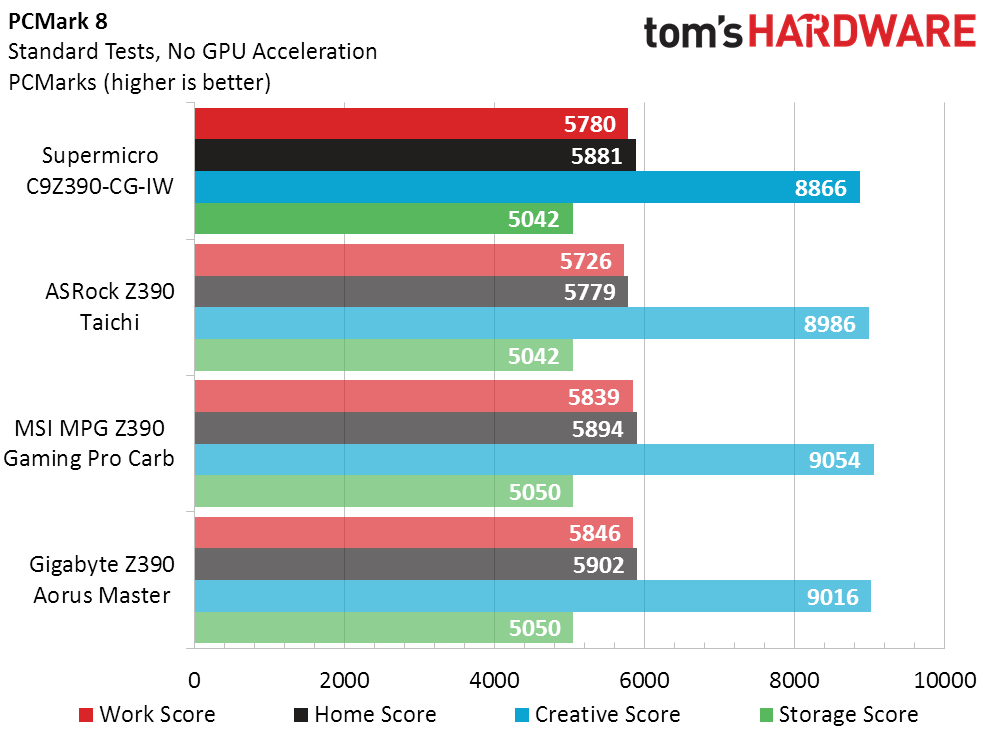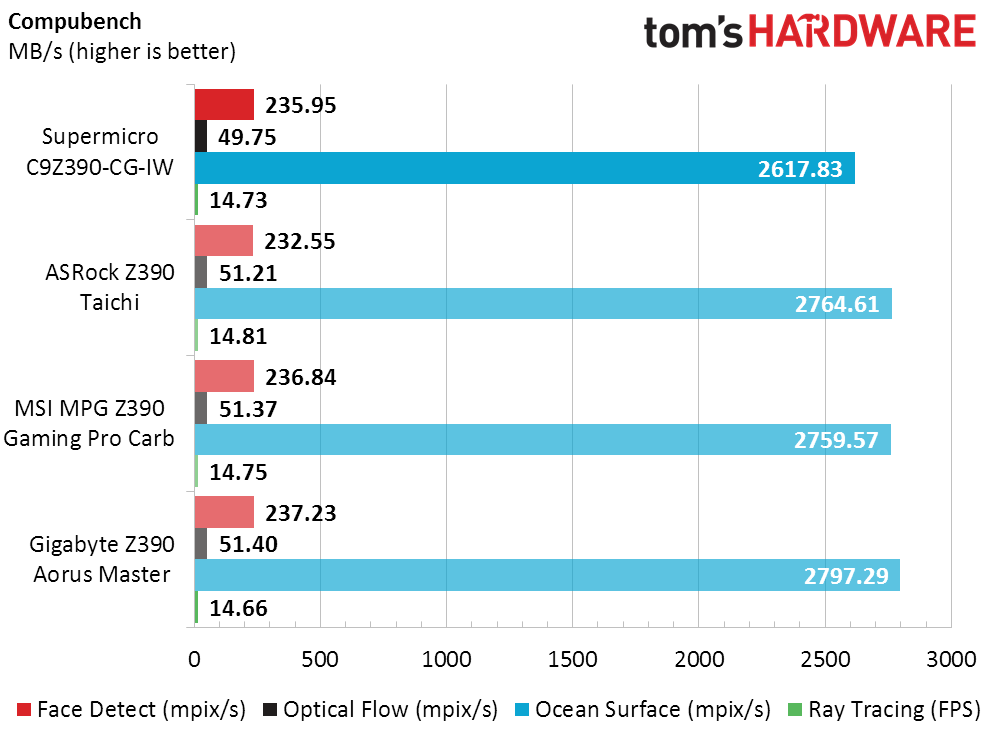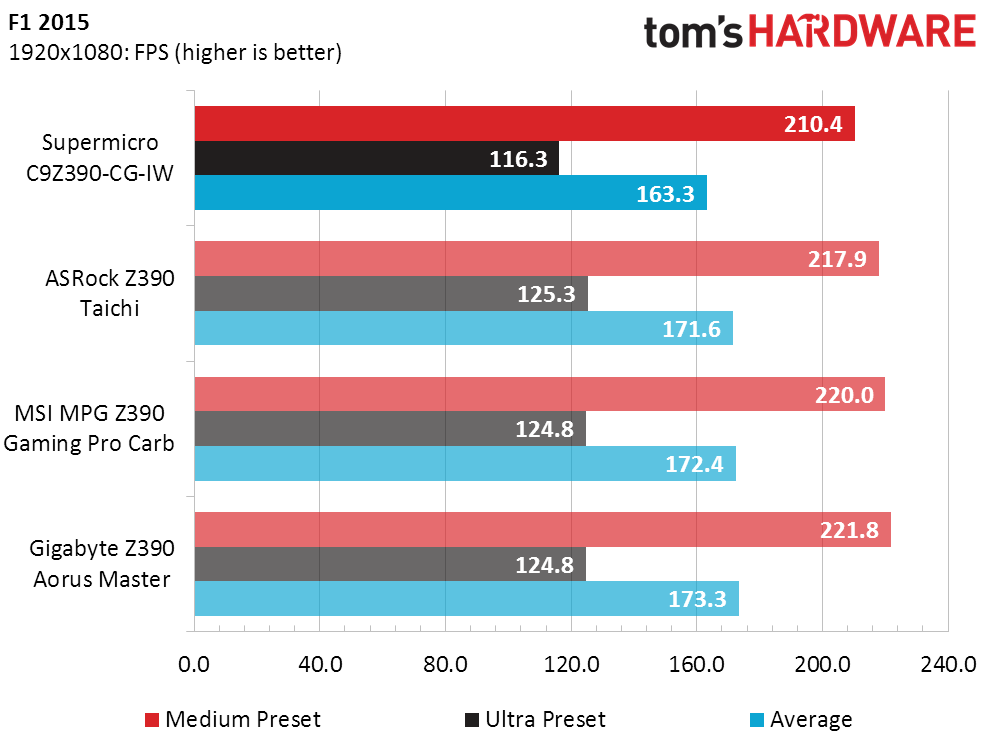Supermicro C9Z390-CG-IW Review: 9900K Meets Mini-ITX
Why you can trust Tom's Hardware
Benchmark Results and Final Analysis
We enabled all CPU-based power saving features in firmware and disabled fixed-mode Intel Turbo Boost manipulations prior to our basic performance and power tests. The maximum Turbo Boost ratio for the Core i9-9900K is 5GHz with up to two cores loaded, and that drops to 4.7GHz when more than four cores are loaded.
Synthetic Benchmarks
While some boards enhance advanced memory timings to get a small advantage in a few benchmarks, the C9Z390-CG-IW suffers from the fact that the boards its being compared to have four DIMM slots. Given that Intel processors consistently show a performance preference for a minimum of four memory ranks and that each module of our four-DIMM kit is single-rank, we’ll cut it a small break.










The C9Z390-CG-IW started out behind the four-DIMM boards at 3DMark’s lowest effort test but gradually caught up as the workload increased. Sandra Memory Bandwidth shows the deficit was due not to a problem with the board, but the CPU’s preference for more memory ranks. The mix put it on par with the others in Cinebench but a stroke or two behind the pack in Compubench.
3D Games
Gaming benchmark history would have us believe that the two-DIMM C9Z390-CG-IW should fall farthest behind at medium settings in F1 2015 and take a minor hit in Ashes of the Singularity, but that’s not exactly what happened. The “good enough” score in Ashes was a little farther off than expected, and the big hit in F1 2015 came at its ultra preset. Perhaps the newer CPU is pushing us to the limits of the graphics card and DRAM?




The oddest result was in Metro Last Light Redux, which our previous configuration showed only took a performance hit when saddled with memory slower than the baseline of these modules. Our expectations are slowly evolving to accommodate the newer CPU.
Timed Applications



Where less time means more performance, the C9Z390-CG-IW keeps us very close to schedule. However, we did see a 30-millisecond loss in PowerPoint.
Power & Heat
This is where things get weird. Sometimes, the C9Z390-CG-IW would shut down when we started Prime95 small-FFTs. Other times, it would shoot up to around 242W before permanently throttling to 3.4GHz, well below the CPU’s rated frequency. Setting a higher power limit in firmware occasionally allowed us to reach 4.7GHz, where we eventually found a 344W full-load power reading. Most of the time, the higher power limit would push the voltage regulator to its critical limit, causing it to power off. It wasn’t until we turned Intel Hyper-threading off that the voltage regulator stayed at full load long enough to get a proper VR thermal reading. Even then the CPU was only pulling 297W.
Get Tom's Hardware's best news and in-depth reviews, straight to your inbox.


A default voltage range of 1.32 to 1.36V for the CPU core was the only data we could find to explain the power throttling issue and high wattage and CPU temperature. In fact, the CPU temperature crossed the board’s default threshold of 100 degrees Celsius (212 degrees Fahrenheit), which resulted from the motherboard’s default setting of 125 degrees Celsius (257 degrees Fahrenheit) being out of range for the CPU. Since the CPU’s thermal limit is 115 degrees Celsius (239 degrees Fahrenheit), restricting the motherboard via a 10-degree thermal offset actually enabled the 100 to 115-degree range.


The great news is that performance was down by only 1.9 percent, despite the performance deficit our CPU encounters when switching from four to two ranks of memory. The C9Z390-CG-IW performed more competitively than we would have expected from a two-DIMM board.
Overclocking
By now you’re probably wondering “If this board was tripping its own circuit breaker at stock CPU settings with power-throttling disabled, how can it be overclocked?” The board does have an OC-mode jumper, but enabling that boosts CPU core voltage to 1.48V, tripping the board's circuit breaker all the faster. But you may also remember that we said it was running up to 1.36V CPU core at stock settings. We actually use less voltage to achieve our overclock!
At 1.3V CPU core, the C9Z390-CG-IW will run all day at 49 x 101 MHz under Prime95 small-FFTs. That’s 16 super-AVX-loaded threads! Could this be the first board we recommend exclusively for overclocking and never for use at the board's default i9-9900K settings?
Even though the C9Z390-CG-IW didn’t make the necessary adjustments to secondary and tertiary settings to properly overclock our DDR4-2933, it did let us run those settings at the same 101MHz base clock. (If you've noticed that the charted bandwidth advantage of the four-DIMM boards is reduced from previous reviews, that's because we’re showing their two-DIMM results.)
Final Thoughts
Our C9Z390-CG-IW review was a wild ride, primarily because the board's default settings couldn’t run our CPU at its full 4.7GHz 8C/16T rating under Prime95. The board throttled our CPU below its non-turbo-boosted 3.6GHz at stock settings and often tripped its thermal protection mechanism with power throttling disabled.
The C9Z390-CG-IW still looks good in a performance-per-dollar chart, and it’s the first Z-series Mini-ITX board we’ve seen in a while with two M.2 storage slots. The biggest problem is that we really can’t recommend it to anyone who wants to run Prime95 small-FFTs on the Core i9-9900K. That may not be a big deal to you, but our reviews require consistency.
Our findings around disabling Hyper-threading (see Power & Heat, above) is especially relevant for those with a Core i7-9700K, since that CPU doesn’t have Hyper-threading. The C9Z390-CG-IW had no trouble running our 9900K with Hyper-threading disabled, and the 9700K presents an even lighter load by being at least 100MHz slower.
For i9-9900K ovecrlocking, you could just overclock at a reasonable voltage, such as the 1.3V we chose. The 4.94GHz we reached under an 8C/16T load still beats the stock 4.7GHz by 5 percent. And if you care enough, we did try setting a -50mV offset at stock frequency settings and came up with a 1.22V CPU core drawing 256W at 4.7GHz in Prime95 small-FFTs. The fix is there, but applying it is up to the buyer.
MORE: Best Motherboards
MORE: How To Choose A Motherboard
MORE: All Motherboard Content
-
siman0 I'm not going to lie here that's fairly impressive given its size. Its probably the best ITX board for the 9XXX series I don't think it deserves a 2/5 just because it cant support one of Intel's ridiculously power hungry CPU...Reply -
bloodroses Reply21449195 said:I'm not going to lie here that's fairly impressive given its size. Its probably the best ITX board for the 9XXX series I don't think it deserves a 2/5 just because it cant support one of Intel's ridiculously power hungry CPU...
I agree. 2/5 is pretty brutal of a rating considering the board runs well with everything but the 9900k; and is loaded to the gills for its size. I wonder if Toms contacted Supermicro to see if there was a bios fix, or something similar? Supermicro is usually known for exceptional quality motherboards and one of the go-to brands for servers. -
Crashman Reply
Update: I reset the firmware after writing the article, booted up, started Prime95 small-FFT's, and the system did a hard reset (overcurrent protection). And you still want something higher than the middle score of 2.5?21449195 said:I'm not going to lie here that's fairly impressive given its size. Its probably the best ITX board for the 9XXX series I don't think it deserves a 2/5 just because it cant support one of Intel's ridiculously power hungry CPU...
It would probably have gotten a 3 or 3.5 if the 9700K were Intel's top CPU, but what we're really looking at with this board is Z370-class power regulation on the Z390. We're assuming the reason Intel delayed the Z390 is that they wanted to get manufacturers to support the power specs of the 9900K. After all, the H370 and B360 are based on the Z370, and the derived chipsets were released first for a reason.
Moreover, if you look at the power consumption, it looks like this board's biggest power shortcoming could have been addressed in firmware. It shouldn't need this much core voltage to run a 8C/16T load on the 9900K at 4.70 GHz.
-
siman0 Well Blood considering what Crashman stated, that's probably a no. Considering it can support a 9900k is impressive for what it is. Id like to see what the board is able to do with updated firmware. But going to be honest people are probably not going to be looking at serious overclocking in a ITX computer. I see the use of this more as a mobile work station and side gaming computer than anything else.Reply -
bloodroses Reply21449575 said:Well Blood considering what Crashman stated, that's probably a no. Considering it can support a 9900k is impressive for what it is. Id like to see what the board is able to do with updated firmware. But going to be honest people are probably not going to be looking at serious overclocking in a ITX computer. I see the use of this more as a mobile work station and side gaming computer than anything else.
I completely agree on the use. HTPC, mini work stations, portable gaming, and micro servers are the main uses for Mini-ITX. The NUC, Mac Mini, Brix, and micro servers in general are perfect examples of those. It's almost crazy even thinking of something as powerful as a 9900k in something that small; but it is an option now. I'm guessing Supermicro is focusing on the server side of things given their pedigree.



